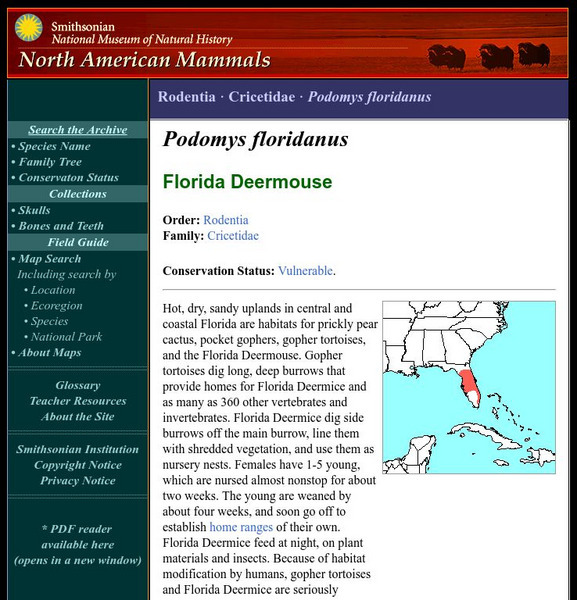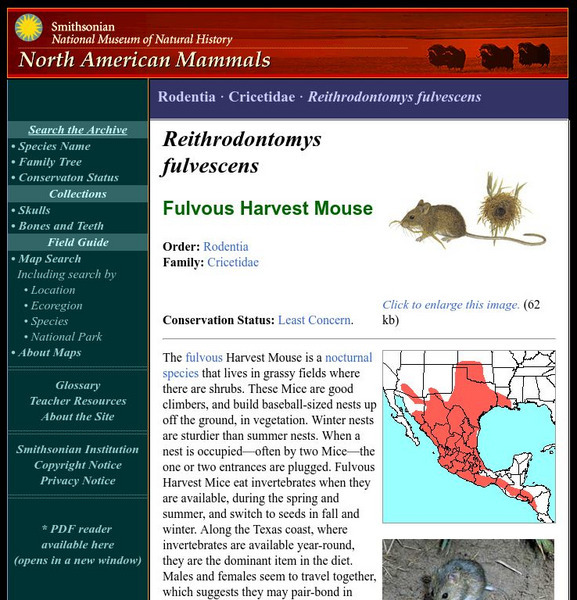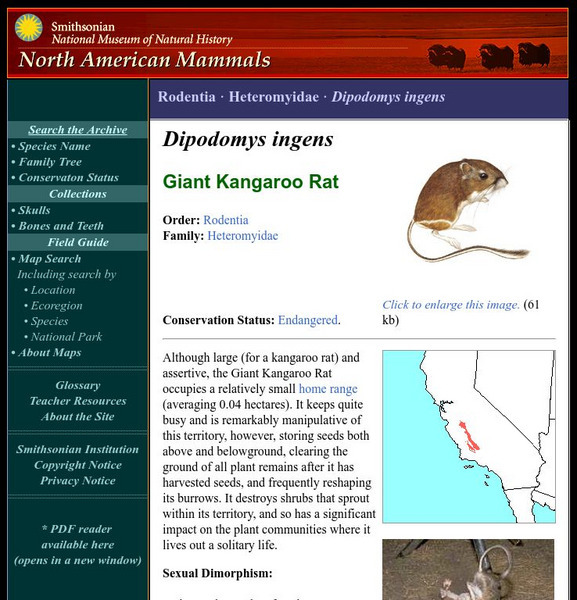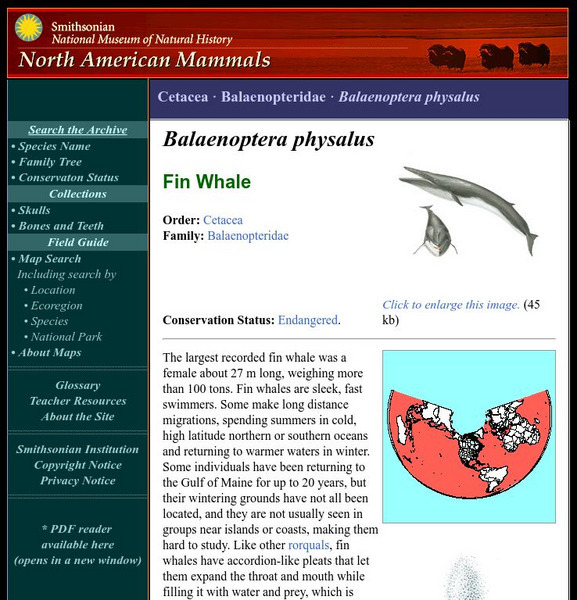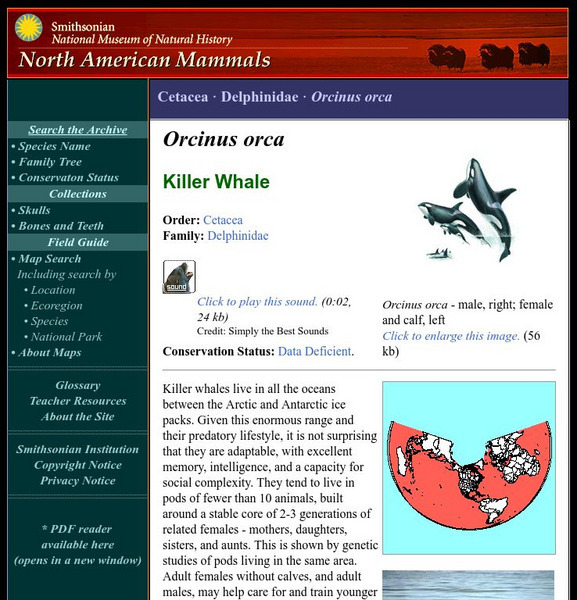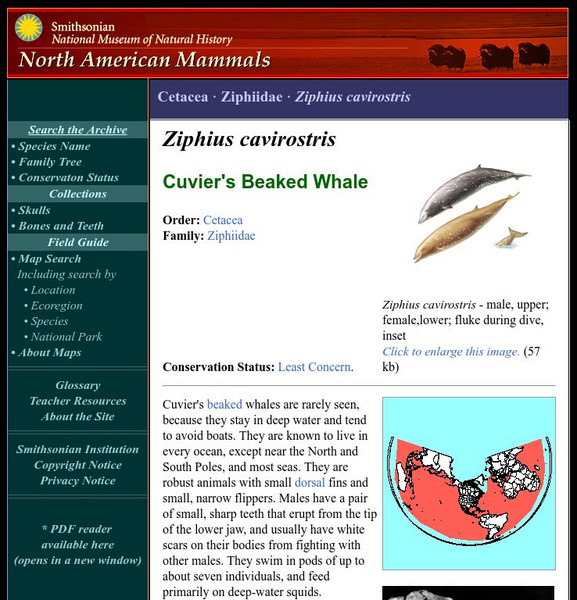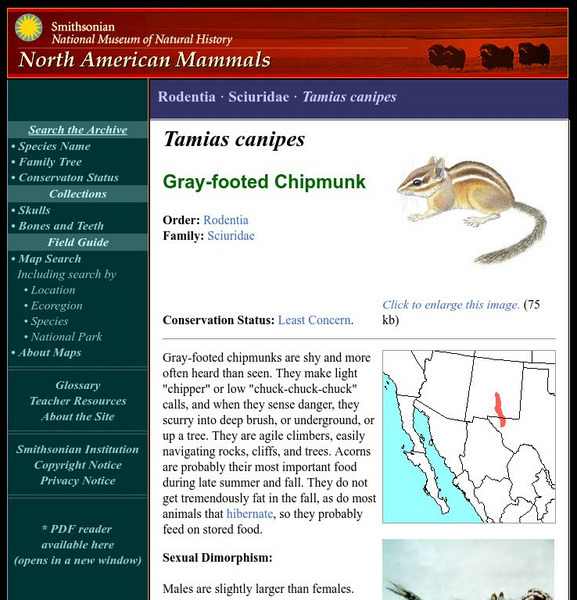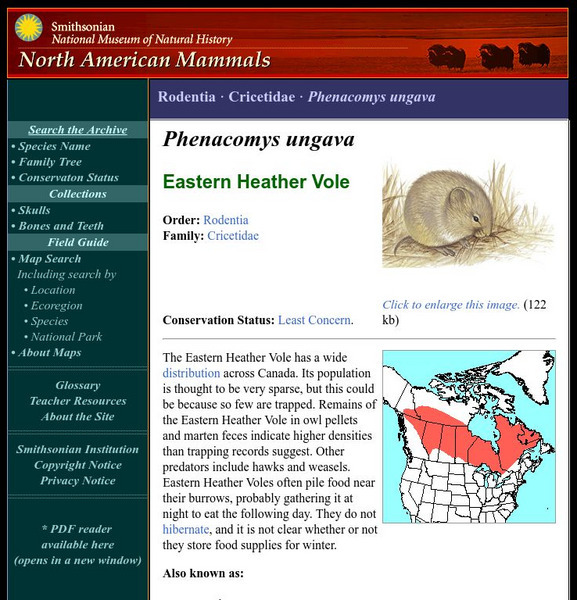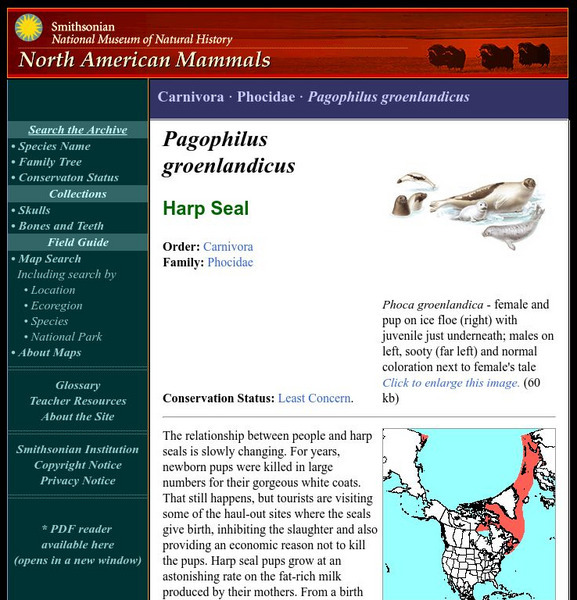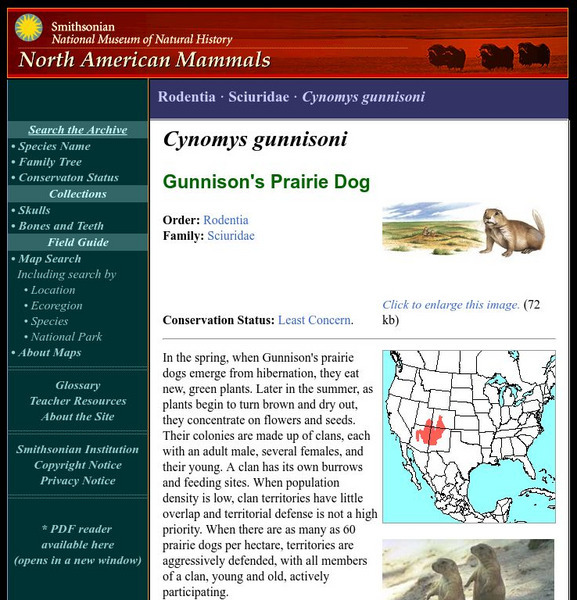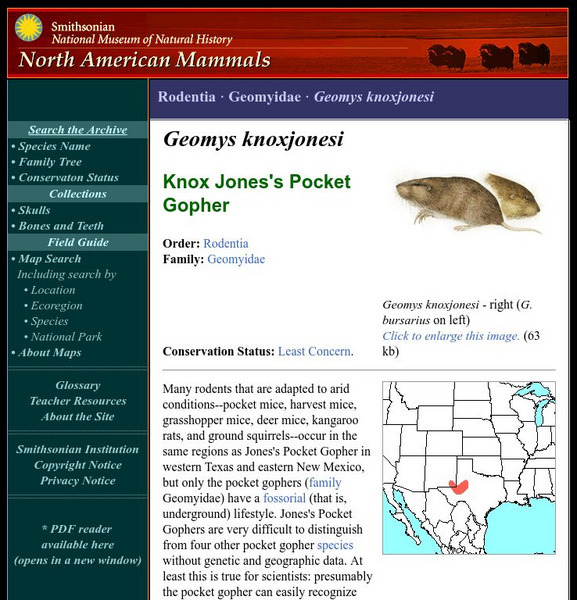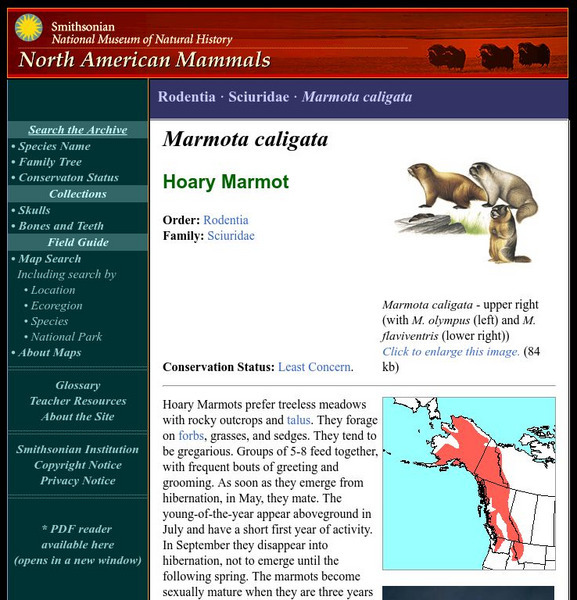Smithsonian Institution
National Museum of Natural History: American Mammals: Keen's Myotis
Keen's myotis is a medium-sized bat with a long tail. It does not demonstrate narrowly specialized habitat needs. Learn more about the Myotis keenii, more commonly known as a Keen's Myotis, in this easy-to-read species overview by the...
Smithsonian Institution
National Museum of Natural History: American Mammals: Florida Mouse
Hot, dry, sandy uplands in central and coastal Florida are habitats for prickly pear cactus, pocket gophers, gopher tortoises, and the Florida Mouse. Gopher tortoises dig long, deep burrows that provide homes for Florida Mice and as many...
Smithsonian Institution
National Museum of Natural History: American Mammals: Fulvous Harvest Mouse
The fulvous Harvest Mouse is a nocturnal species that lives in grassy fields where there are shrubs. These Mice are good climbers, and build baseball-sized nests up off the ground, in vegetation. Learn more about the Reithrodontomys...
Smithsonian Institution
National Museum of Natural History: American Mammals: Desert Cottontail
Living well below sea level in Death Valley and also in woodland and grassland up to 2,000 m elevation, Desert Cottontails are able to tolerate diverse habitats. They are most active at dawn and dusk and spend hot days resting in a...
Smithsonian Institution
National Museum of Natural History: American Mammals: Giant Kangaroo Rat
Although large (for a kangaroo rat) and assertive, the Giant Kangaroo Rat occupies a relatively small home range (averaging 0.04 hectares). Learn more about the Dipodomys ingens, more commonly known as a Giant Kangaroo Rat, in this...
Smithsonian Institution
National Museum of Natural History: American Mammals: Fin Whale
The largest recorded fin whale was a female about 27 m long, weighing more than 100 tons. Fin whales are sleek, fast swimmers. Learn more about the Balaenoptera physalus, more commonly known as a Fin Whale, in this easy-to-read species...
Smithsonian Institution
National Museum of Natural History: American Mammals: Killer Whale
Killer whales live in all the oceans between the Arctic and Antarctic ice packs. Given this enormous range and their predatory lifestyle, it is not surprising that they are adaptable, with an excellent memory, intelligence, and a...
Smithsonian Institution
National Museum of Natural History: American Mammals: Dall's Sheep
Dall's Sheep inhabit undisturbed and extremely rugged mountains. They migrate between summer and winter ranges, eating grasses and shrubs. Learn more about the Ovis dalli, more commonly known as a Dall's Sheep, in this easy-to-read...
Smithsonian Institution
National Museum of Natural History: American Mammals: Eastern Spotted Skunk
Spotted skunks are smaller than Striped skunks and more weasel-like in appearance. Like all skunks, they have anal scent glands and can emit a foul-smelling spray to protect themselves. Learn more about the Spilogale putorius, more...
Smithsonian Institution
National Museum of Natural History: American Mammals: Cuvier's Beaked Whale
Cuvier's beaked whales are rarely seen because they stay in deep water and tend to avoid boats. They are known to live in every ocean, except near the North and South Poles, and most seas. Learn more about the Ziphius cavirostris, more...
Smithsonian Institution
National Museum of Natural History: American Mammals: Gray Whale
Gray whales are bottom feeders. They roll to one side and lower the lip to scour and siphon the bottom for tiny crustaceans, especially amphipods which are known as "sand fleas." Learn more about the Eschrichtius robustus, more commonly...
Smithsonian Institution
National Museum of Natural History: American Mammals: Humpback Whale
Humpback whales are among the best-studied cetaceans, yet they are still among the most mysterious. Among the mysteries are the reasons for their songs and the complex social behaviors that accompany them. Learn more about the Megaptera...
Smithsonian Institution
National Museum of Natural History: American Mammals: Ermine
Ermine are highly adaptable predators, easily invading small burrows to feed on voles, mice, and young rabbits. They also eat earthworms, frogs, and squirrels, climbing trees and swimming if necessary. Learn more about the Mustela...
Smithsonian Institution
National Museum of Natural History: American Mammals: Eastern Chipmunk
Eastern chipmunks are found in forests, but also in suburban gardens and city parks, as long as there are rocks, stumps, or fallen logs to provide perching sites and cover for burrow entrances. They dig complex burrows with many...
Smithsonian Institution
National Museum of Natural History: American Mammals: Gray Footed Chipmunk
Gray-footed chipmunks are shy and more often heard than seen. They make light "chipper" or low "chuck-chuck-chuck" calls, and when they sense danger, they scurry into deep brush, underground, or up a tree. Learn more about the Tamias...
Smithsonian Institution
National Museum of Natural History: American Mammals: Desert Pocket Gopher
The Desert Pocket Gopher is built for digging, with strong front legs and massive claws. Small eyes and ears are adaptations for traveling through tunnels. Learn more about the Geomys arenarius, more commonly known as a Desert Pocket...
Smithsonian Institution
National Museum of Natural History: American Mammals: Eastern Heather Vole
The Eastern Heather Vole has a wide distribution across Canada. Its population is thought to be very sparse, but this could be because so few are trapped. Learn more about the Phenacomys ungava, more commonly known as an Eastern Heather...
Smithsonian Institution
National Museum of Natural History: American Mammals: Harp Seal
The relationship between people and harp seals is slowly changing. For years, newborn pups were killed in large numbers for their gorgeous white coats. Learn more about the Phoca groenlandica, more commonly known as a Harp Seal, in this...
Smithsonian Institution
National Museum of Natural History: American Mammals: Idaho Pocket Gopher
Idaho Pocket Gophers are active all year long. When they excavate burrows in the winter, they leave the dirt piled in snow tunnels. Learn more about the Thomomys idahoensis, more commonly known as an Idaho Pocket Gopher, in this...
Smithsonian Institution
National Museum of Natural History: American Mammals: Gunnison's Prairie Dog
In the spring, when Gunnison's prairie dogs emerge from hibernation, they eat new, green plants. Later in the summer, as plants begin to turn brown and dry out, they concentrate on flowers and seeds. Learn more about the Cynomys...
Smithsonian Institution
National Museum of Natural History: American Mammals: Hooded Seal
Male hooded seals have a fleshy sac above the nostrils that they can inflate. It grows as the animal gets older, and looks a lot like a hood over the nose, thus the name "hooded seal. Learn more about the Cystophora cristata, more...
Smithsonian Institution
National Museum of Natural History: American Mammals: Jones's Pocket Gopher
Many rodents that are adapted to arid conditions--pocket mice, harvest mice, grasshopper mice, deer mice, kangaroo rats, and ground squirrels--occur in the same regions as Jones's Pocket Gopher in western Texas and eastern New Mexico,...
Smithsonian Institution
National Museum of Natural History: American Mammals: Hoary Bat
Hoary bats are found from northern Canada all the way to Guatemala, and also in South America and Hawaii. They are solitary and roost in trees. Learn more about the Lasiurus cinereus, more commonly known as a Hoary Bat, in this...
Smithsonian Institution
National Museum of Natural History: American Mammals: Hoary Marmot
Hoary Marmots prefer treeless meadows with rocky outcrops and talus. They forage on forbs, grasses, and sedges. Learn more about the Marmota caligata, more commonly known as a Hoary Marmot, in this easy-to-read species overview by the...

